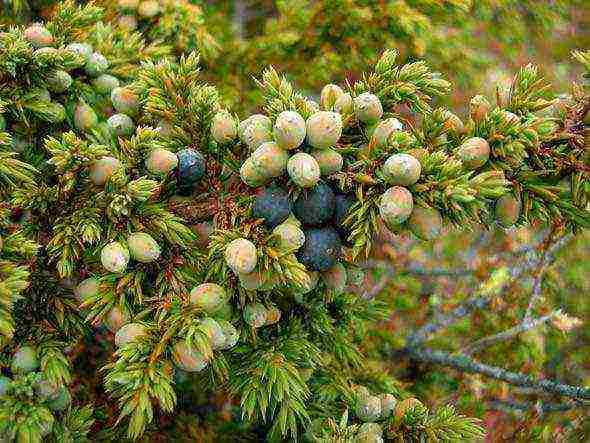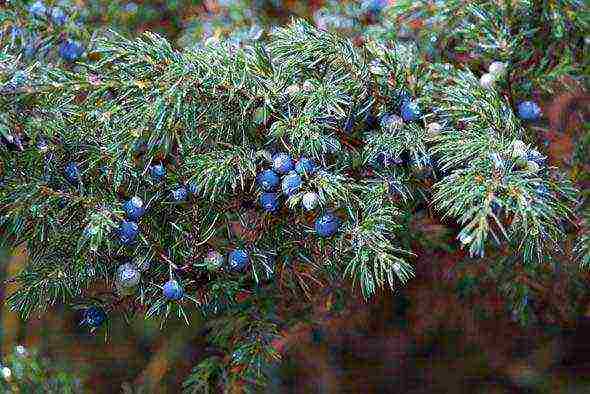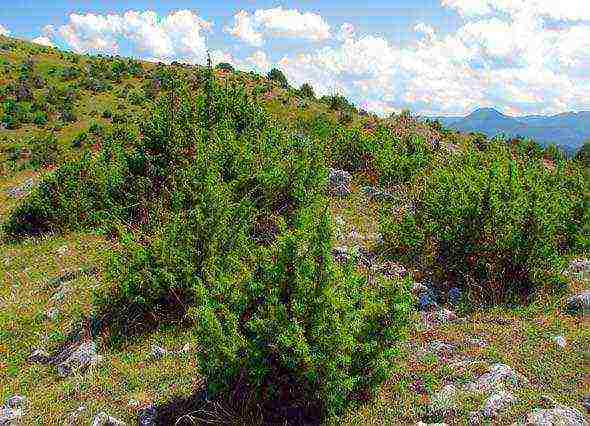Content
- 1 How to properly plant a juniper in open ground
- 2 Juniper, care in the garden and in the country
- 3 When a juniper is planted
- 4 Juniper planting rules
- 5 Transplanting juniper from the forest
- 6 Plant features
- 7 Types and varieties for a summer cottage
- 8 How to choose a seedling
- 9 Where and when is it better to plant a juniper on the site
- 10 How to plant an ephedra correctly
- 11 Care rules

A beautiful juniper, planting and care in the open field for which is not too difficult at first glance, still require attention from the gardener in order to delight the owners with a beautiful and healthy look and, you need to know how to do it all correctly, at what time, in the fall or in the spring, how to feed the plant, how to transplant it to a new place, how to spray it against yellowing and rust, how is pruning done, etc.
How to properly plant a juniper in open ground
Planting in open ground is a laborious process with many nuances, the observance of which will allow you to enjoy a beautiful plant in the country or in the garden.
The best time for planting junipers is the beginning of spring, when the frosts have already ended, but the weather is not too warm yet. An excellent option would be the period when the snow melts. Of course, you can plant the plant later, but then there is a danger of burning out the needles. It should be said that in a later period, young growth should be planted.
Many are interested in the question of how to plant a juniper in the fall. In this case, the plant may not have time to take root, as a result it will die. It is important to note that if a juniper has a closed root system, then it can be planted at any time of the year.
When choosing a site for juniper, take care of constant sun. The sun's rays should shine on the plant all day. Only on hot summer days, some juniper varieties require shading.
How much light hits the plant depends on its appearance. If shade prevails on the site, then the plant will grow poorly. The brightly colored juniper will no longer have the original color of the needles.
As for the choice of soil, then the type you choose plays an important role here. So, for the Cossack, ordinary and Central Asian varieties of juniper, soil is required, which includes dolomite flour or slaked lime.
Siberian juniper loves sandy or sandy loam soil, for Virginia - clay soil with compost is suitable.
The remaining species take root well if peat, sand, a protective layer with peat and wood chips are added to the soil to create an acidic reaction.
The plant is sold in various containers. The most suitable plant for planting is a plant in containers, with a volume of 5 liters pots with a closed root system. If you buy a seedling with an open root system, be sure to check the roots, they are white and quite strong. Do not buy a juniper if you notice damage to it.
When planning to plant large plants, then certain skills or the help of a specialist will come in handy here. These plants are pre-grown in the ground and must be dug up to be sold.
True, experts do not recommend planting grown adult plants. This is due to the fact that during growth the roots go far into the ground, when excavated, the main root is often damaged, which leads to the fact that the juniper dies after transplantation. Therefore, an adult juniper should be planted in the winter with a frozen soil ball.Disembarkation at such a time increases the chances of good survival and healthy development in the future.
Remember, before planting, be sure to moisten the lump with plenty of water, about 2 hours before planting.
Prepare the site in advance. Dig a hole in it, the size of which directly depends on the size of the plant. For example, a 1m × 1m pit with a depth of 50 cm is suitable for a young plant. Experts recommend making a pit 2 times the size of a soil ball.
At the very bottom of the pit, where it is planned to plant the plant, drainage is added, with a layer of about 20 cm (it is better to use broken brick, large pebbles and sand). The free space is filled with cultivated soil. This kind of soil is suitable for any kind.
When placing, be very careful not to damage the root system and the earthy ball. Make sure that in young plants the root collar is at the surface of the ground, and in adult specimens it rises by about 10 cm.
Then pour plenty of water. The area near the trunk is covered with a protective layer (mulch), which can be peat, pine bark, chips, sawdust, crushed cones or pine nut shells. The mulch should be 10 cm thick.
Transplanting a juniper from the forest is not very difficult, the main thing is to follow the rules:
- Only young and small plants are suitable for transplanting, because they have not yet formed a large root system
- After you choose a plant, be sure to mark the sunny side of it (so as not to get confused, before digging out), and plant it on the exact same side
- Dig up the plant along with a lump of earth, place it in a film or burlap, wrap and tie
- Plant in the same way as for a plant purchased from a nursery.
Juniper, care in the garden and in the country
Summer residents appreciate the juniper for its beauty and ease of care. By adhering to some rules of care, you can grow a healthy and beautiful plant.
A juniper goes without water for a long time, but in the summer it should be watered at least once every 30 days. As practice shows, this happens much more often, especially in hot sultry weather, you need to water the plants every day.
Sometimes it should be sprayed with plain water from a spray bottle. Spraying is best done weekly in the morning or evening, so as not to burn the green part of the bush.
In the spring, the soil is fertilized with nitroammophos in a proportion of 45 grams per 1 sq. M. In the summer, you can use organic fertilizers and mineral fertilizers, if the plants require it. Fertilize the soil if the juniper grows poorly.
As for the transplant, the juniper takes root very poorly, therefore, it is carried out only if necessary. To do this, be sure to prepare the soil - mix sand, coniferous soil and peat in equal proportions. After transplanting, pour water well.
Juniper does not require pruning, you just need to remove dry branches. If you want to create a beautiful crown, then you cannot cut off too much, the plant will get sick.
In winter, the young juniper is covered with lutrastil, the adult plant is simply tied up so that the branches do not break off under the weight of the snow. If there is a lot of snow, shake off the plant occasionally.
The onset of spring is a dangerous period, the sun can burn out the needles. To avoid this, shade the juniper with a cloth or burlap. When the snow has completely melted, the burlap can be removed. Clean the trunk circle, remove the protective layer so that there is no root rot. Dig up and loosen the ground. After the soil has dried, a new protective layer can be applied.
Now you know, dear readers, that a juniper, planting and caring for which is not difficult, can delight you with a beautiful view for many years.
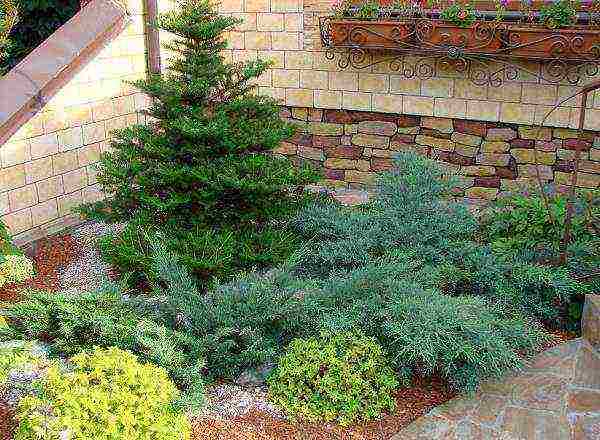
A modern way to green up the territory, to give it a noble, well-groomed look is to plant a juniper.It is a close relative of cypress, but grows in harsher conditions. Different types and varieties (about 15 items: dwarf, giant, erect, spreading) will help the designer create a real masterpiece on the site. The juniper, the planting and care of which will be described in the article, has various shades of green, dove-gray. Depending on the season, the crown of the needles changes color to a bronze color.
Content:
When a juniper is planted
Planting time can be selected in spring and autumn. The juniper will feel good in the open field in April, May, October, but the place for it should be chosen without completely darkening the plant, you can only partially. Indicators of hydrogen in the soil should be in the range of 4.5-7 units. taking into account the variety.
On a note! Designers love juniper for its unpretentiousness to soil and climate. It can grow even on heavy loams and sandy soils, except for wetlands. In winter, he does not need shelter, unless we are talking about young cuttings.
The question of how to properly plant a juniper in spring should also include a study of the soil in order to exclude the death of the plant.
Where to plant a plant
Juniper loves direct sunlight, so it is basically planted in open areas. Otherwise, the shade will lead to the loss of the bright, saturated color of the needles, degenerative crown formation. Only a slight absence of the sun can only be tolerated by one variety - the common juniper.
A feature of all species is the development of a long, voluminous root system, so the landing site can even be slopes, unstable soils that need strengthening.
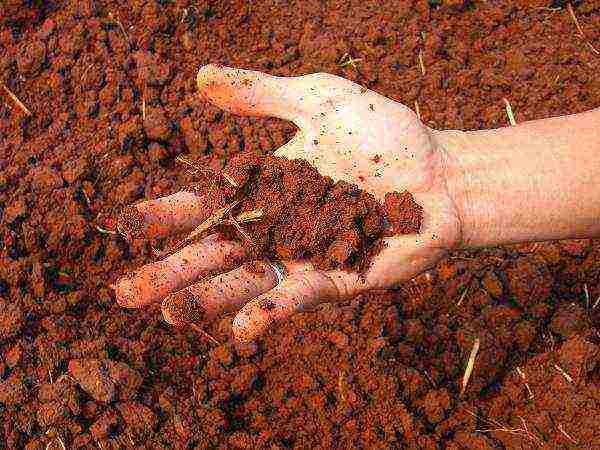
Important! Juniper does not like long-term soaking, so landing on lowlands and in marsh areas is not recommended.
If the question is: what to plant next to a juniper, then you should avoid the neighborhood with mountain ash, hawthorn and apple trees, which can be carriers of fungi that infect plant crowns.
Juniper planting rules
How to plant a plant at home correctly? The basic rule is to maintain certain parameters:
- from 1.5 to 2 m from each other;
- the dimensions of the pit for a small seedling are 50 × 50 × 50 cm, for a large one from 70 × 70 × 70 cm.
The preparation of the pit begins in 2 weeks, forming a pillow from the following layers:
- drainage (finely broken brick + sand) up to 20 cm thick;
- nutrient soil with top dressing - 1 part of soddy-clay soil + 1 part of sand + 2 parts + 250 g of nitroammophos.
The peculiarity of each type of juniper should be taken into account. Growing a Virginia specimen will not be successful if 5 kg of compost and 5 kg of clay are not added to the base mixture (with poor, sandy soil). In the case of the Cossack juniper, up to 300 g of dolomite flour are mixed into the soil.
After 2 weeks, when the soil shrinks, you should start planting the seedling. It is placed in a prepared pit and covered with the same soil composition as in the pit, excluding top dressing.
Important! Before planting a juniper in the country or in another area, you should remember about the correct location of the root collar in the pit. For small seedlings, it is allowed to be located at ground level, for large ones - up to 10 cm above ground level.
After planting, the plant is watered abundantly, and after shrinkage of the earth, it is mulched with a small (up to 8 cm) layer of a mixture of sawdust and peat.

Planting seedlings
The main conditions for the early survival of seedlings are:
- 3-4 years of age;
- container where the plant grew (up to 5 liters);
- no signs of any disease;
- preserving the integrity of the earthen coma on the roots in order to exclude damage to the root system;
- reputable garden center.
Planting of seedlings is carried out at any time of its growing season, except for very hot days. Pre-dip the root system in water for 2 hours, you can add a little potassium permanganate.If a young plant has open roots, then planting is recommended in spring, at the end of summer, while the soil should be moist. For the development of healthy roots, a root formation stimulant is used.
If you follow all the points when choosing, then the seedling will quickly settle into the soil, and you will not need to use additional aids for transplanting.
How to grow a juniper from seeds
Planting with seeds is a complex process that requires a certain amount of experience. A feature of a coniferous plant is its low germination rate. You may be lucky and the plant will sprout, but it will be difficult to preserve it.
With patience and some botanical knowledge, this is possible. Planting is carried out in the fall, in a pot, which is taken out in the winter to an open area for 4 months (regardless of the weather).
The dead seeds are thrown away, and the survivors are planted again in the pot in May, still leaving them outside. Shoot can only be expected next year.
Important! Regardless of the species, juniper grows very slowly, and in order to speed up the germination process, fertilizers are added, and also provide a favorable regime - sun, soil moisture.
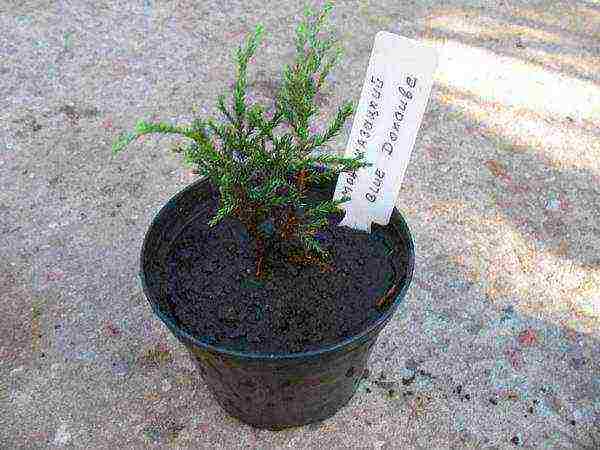
How to grow a juniper from a cutting
The question arose, how to plant a handle? The best option would be a small pot of earthen mixture (1 part peat + 1 part sand + 0.25 part turf).
From a coniferous tree, whose age has reached 10 years, an annual cutting about 12 cm long is cut along with the wood. In a jar of water, a mixture is diluted to stimulate growth and a branch is lowered into it to a depth of 3 cm.If the stalk was cut without wood, then you need to watch the top so as not to put this particular side in the water.
Important! Before you propagate a juniper from a branch, you should consider its type. The creeping plant is lowered into a jar with a growth solution at a 60 ° slope, and the columnar plants are placed vertically.
Common juniper lends itself to propagation through cuttings much better (90%) than other species. If the root system is actively developing, then you can transplant the plant into a separate pot. The only condition is to transplant into open ground in at least 2 years.
How to fertilize and feed seedlings and young plants
The soil for a juniper should consist of a mixture of nutrients and fertilizers, only when this condition is met, growth will be active and the plant will be resistant to pathogens of various diseases.
Important! When choosing a seedling, you should pay attention to its ability to grow. The needles should not be dry, not have any damage and signs of diseases (mold, fungus), and an earthen lump should be present on the roots.
How to feed properly? In the spring, mineral fertilizers are applied: superphosphate or nitroammophos. If juniper propagated by cuttings or young planting material from a nursery was planted in the ground, then soil properties are improved every spring, summer (with obvious signs of poor growth and a lack of minerals).
By the state of the shoots, you can determine the excess or lack of a trace element:
- yellowing of the needles indicates a magnesium deficiency;
- deformation of the crown, death - a large amount of nitrogen. It is found in organic fertilizers (manure).
Growing young planting material is impossible without fertilization. You should also consider what kind of soil the juniper likes. By adhering to these recommendations, you can grow a lush, healthy plant with juicy needles.
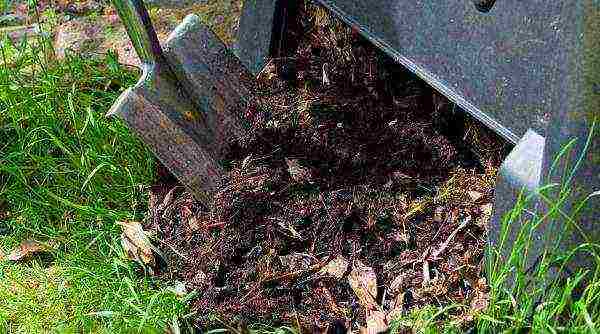
Top dressing of an adult plant
It is possible to grow an adult tree without fertilizers, but for a rich color and splendor of the crown, foliar dressing is used. In dry summers and before the predicted frosts in autumn, the juniper is watered abundantly, which is necessary for the accumulation of moisture.
Transplanting juniper from the forest
How to transplant a juniper from a forest to a site? The best period for moving is early spring, when the snow has not completely melted yet. The following recommendations should be adhered to:
- Before transplanting into the garden, while still in the forest, you need to bandage the sunny side of the plant with a ribbon and plant in the same orientation.
- Dig only with the "mother" earthen clod on the root system. If it is heavy, then it is allowed to comb it vertically with a shovel, reducing the depth.
- Put an earthen lump with a tree on polyethylene and wrap it up for transportation. This will keep moisture in.
- Landing should be done in a single or trench way, avoiding placement near buildings (sliding snow in winter can damage the crowns).
- The size of the pit should be slightly larger than the earthen lump (they provide for the placement of a soil mixture of peat, compost, sand), shallow so that the root collar does not fall below ground level.
- The roots are straightened in the pit and covered with earth and coniferous litter (sawdust).
- Form an irrigation bowl and pour out 2 buckets of water to compact the soil.
Reproduction of a tree and its survival in a new place depends on the degree of care for it. It is especially important to pay attention to the plant in the first six months, until the root system completely takes root in the soil. To limit growth, pruning of junipers in early May is recommended.
One of the popular solutions for landscaping a summer cottage is a coniferous tree. Among the ornamental conifers, the juniper stands out: this plant has many varieties and adapts well to adverse conditions. Planting and caring for it is not difficult, but the plant has several preferences for the place of growth, warmth and humidity.
Plant features
The genus juniper is a representative of the cypress family. Among the species of this genus, both trees and shrubs are found. The height of trees reaches 30 m, shrubs - up to 1.5 m. The shape of the crown of the tree is usually cone-shaped or pyramidal, the bush is creeping. It is formed by flexible branches, densely covered with scaly or needle-like needles. This is why a tree or bush appears lush.
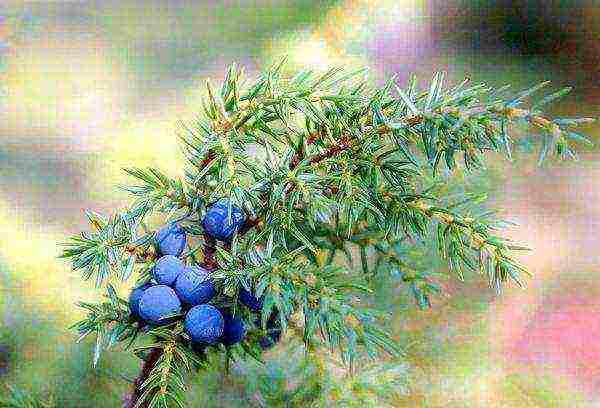
The variety of juniper varieties allows you to choose a tree for any composition, taking into account the possibilities of the site. Of interest is not only the various shades of needles, but also the fruits of the juniper - cones. They are dark blue and have both beauty and useful properties. The needles of a plant release phytoncides into the atmosphere - substances that disinfect the air and saturate it with a pleasant aroma. The smell is also emitted by the wood of juniper.
Types and varieties for a summer cottage
The variety is selected in accordance with the growing region. There are decorative forms of junipers that will tolerate long-term frosts well in the Urals and Siberia. Most of the representatives of the genus are not demanding on watering, wintering, feeding and do not need pruning. At the same time, junipers are not very susceptible to diseases and pests.
There are about 70 species of juniper, 15 of them are cultivated, but the most popular are scaly, rocky, ordinary, Chinese, horizontal, Cossack, middle and Virginian. For outdoor cultivation, frost-resistant varieties are often used. The most unpretentious species are rocky and Virginia.
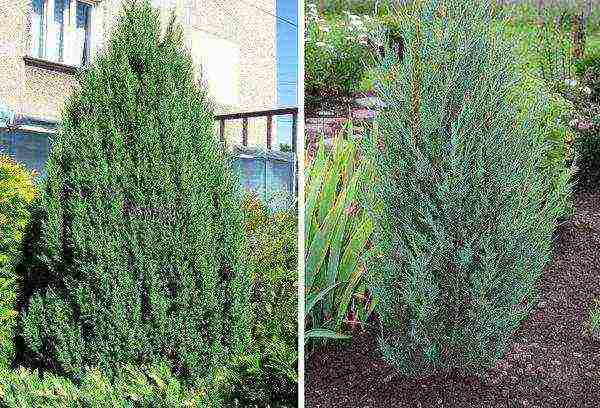
Popular decorative species and varieties:
- Common - a kind of cone-shaped juniper. The tree grows up to 10 m, but develops very slowly. The plant has a lifespan of approximately 200 years. The species is frost-hardy, not particularly demanding, grows well in partial shade and in drought conditions.
- The rocky Blue Errow variety is a representative of the rocky juniper species. They are very hardy, cope with drought, frost. This tree is of medium height, usually no more than 5 m. Blue Arrow has a narrow conical crown and rich blue needles. Looks most decorative on rocky areas.
- Juniper Chinese Strikta is a tree up to 2.5 m tall with vertically growing branches. Thorny needles in spring have a blue-green tint, and by winter they become steel.
- Meyeri is an evergreen shrub. The needles at the tips are silvery-blue. An excellent participant in the mixborder.
- Horstmann is a tall shrub with drooping branches, which makes it look like a weeping willow. Shoots cover up to 2 m in diameter. The needles are small, prickly, dark green.
- Juniper scaly Holger is a spreading bush, the decorative effect of which is a combination of dark green old needles and young golden needles.
- Prince of Wales is a horizontal juniper. One of the most popular species, it forms dense dark green thickets.
- Juniper scaly Blue svid is a shrub with blue needles, which acquire a metallic hue by winter. The bush has a compact cushion shape. Its height does not exceed 1.5 m.
- Old Gold is a representative of the medium juniper species. This species is a hybrid of common and Cossack junipers. The variety is a shrub with golden needles.
- Mint julep is another medium juniper variety. This is a shrub with a spreading crown, its needles are rich green. Demanding on the light.
- Andorra compact is a variety of horizontal juniper. This shrub does not exceed 0.4 m, but it is 1.5 m in diameter. The needles are scaly, blue-silver.
- Repanda is a creeping evergreen shrub of the common species. Unpretentious in care, withstands frosts. Suitable for creating a coniferous lawn.

How to choose a seedling
The best planting material is bought in special containers. Such conifers develop well after transplantation. Another option is a tree with a lump of earth, which is wrapped in wet burlap.
Recommendations for choosing a seedling:
- It should be 3-4 years old, such a plant tolerates transplanting better.
- The root system is closed, but open is also allowed.
- The color of the needles is uniform, corresponding to the variety.
- There should be no cracks or other damage on the bark of the trunk.
Where and when is it better to plant a juniper on the site
Juniper cultivation starts with choosing the right planting site. These ephedra prefer good lighting and usually do not tolerate shading well. Sunlight is especially important for varieties with an unusual color of needles.

Other requirements for the landing site:
- It should not be waterlogged or close to groundwater.
- Protection from drafts is mandatory - junipers react poorly to constant exposure to direct air currents.
- The plant is planted at a distance from buildings and other plants.
The soil for cultivation should be light, loose and fertile. Junipers grow well on sandy, sandy loam and loamy soils. For dwarf specimens, soils with an average nutrient content are better. Their abundance negatively affects the decorative properties of conifers.
It is customary to plant junipers in the spring, when it gets a little warmer. The planting time depends on the type of root system. It is better to plant with open roots in April or September, with closed ones - at any time from April to October.
How to plant an ephedra correctly
Planting and caring for junipers is easy. You just need to adhere to a few rules, and then the plant will develop healthy and strong. When a good landing site has been selected, you need to prepare a landing pit. Its size depends on the size of the root system, it should be about 2.5 times the size of a clod of earth with roots. On average, for small seedlings, a hole is dug 50 × 50, for large ones - 70 × 70.
How to plant a juniper correctly:
- A drainage layer is laid at the bottom of the planting pit so that the plant does not suffer from moisture stagnation at the roots. Expanded clay, broken brick, sand are taken as drainage.Drought is not as terrible for the ephedra as the constant waterlogging of the soil.
- If the soil on the site is too clayey and heavy, then a mixture of garden soil and coniferous, sand and peat must be added to the hole. An example of a substrate for planting: 2 parts of peat, 1 part of sand, 2 parts of humus and 2 parts of turf.
- For tall varieties, it will not be superfluous to add fertilizers to the planting pit. Suitable "Kemira wagon" in the amount of 150 g or 300 g of nitrophoska.
- Seedlings grown at home are moved from the pots by the transfer method - that is, together with a clod of earth on the roots. This will minimize possible damage to the root system. You need to plant the plant quickly so that the roots do not have time to dry out. This is especially true for purchases with an open root system.
- The seedling is sprinkled with the remaining substrate, tamped a little. The root collar must remain above the soil level.
- It remains to water each hole abundantly with warm settled water and mulch the near-trunk circle. This is necessary to retain moisture. Mulch also prevents weeds from growing. Mulch composition: peat, wood chips.
- After planting, you can apply fertilizer for growth - "Epin".
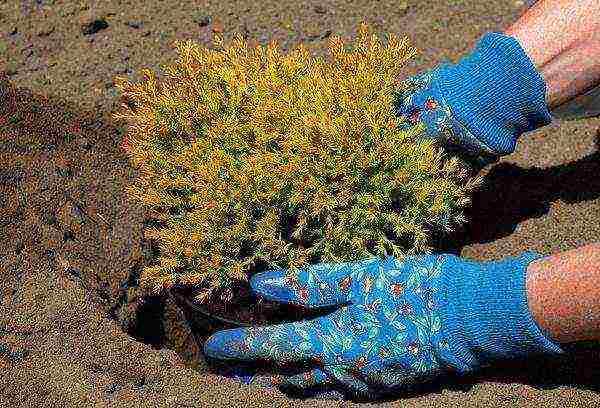
Advice! When planting a group of plants, keep a distance of 0.5 to 2 m between seedlings, depending on the type of planting and the size of the adult plant.
Care rules
To properly care for ornamental junipers, you need to know their preferences. Many varieties love light and moderate humidity, but not all of them tolerate drafts and polluted air.
Young plants need protection from the midday rays of the sun, as fragile needles and bark are afraid of burns. Mature shrubs and trees do not need shading, as the plant as a whole is light-requiring.
Junipers are prized for their drought tolerance, but that doesn't mean you can leave them dry for long periods of time. During a period of intense heat, one bush takes an average of 10-20 liters of water. For some varieties, spraying is of great importance. So the needles are cleaned of dust and saturated with moisture. The procedure is recommended to be carried out in dry weather in the evening or morning, when the sun will not actively evaporate the drops. If you spray the top of the juniper during the day, there is a risk of burns.
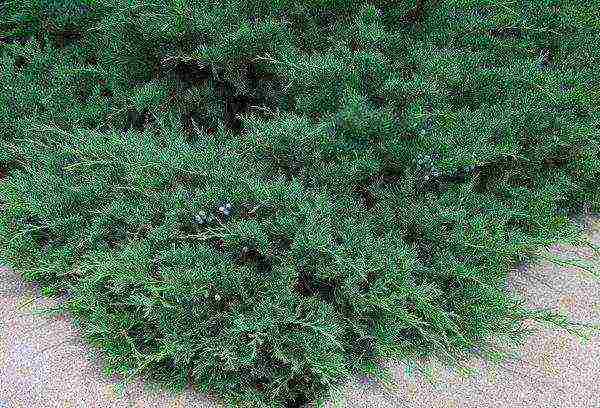
To get air to the roots, after each watering, a small loosening of the soil is carried out. More often it is required for young animals while they are actively developing. If mulching is carried out, then it is not necessary to loosen the soil.
Fertilizing the junipers is optional. Only in dry periods it is advisable to introduce complex fertilizing or fertilizers with nitrogen into the soil, 2-3 times per season.
Hygienic pruning is carried out every spring: all dried and damaged branches must be removed. A haircut for shaping is rarely carried out, since junipers do not differ in their growth rate. Shoots should be shortened by no more than a third. It is not necessary to form tapeworm plants, but bushes in hedges are necessary.
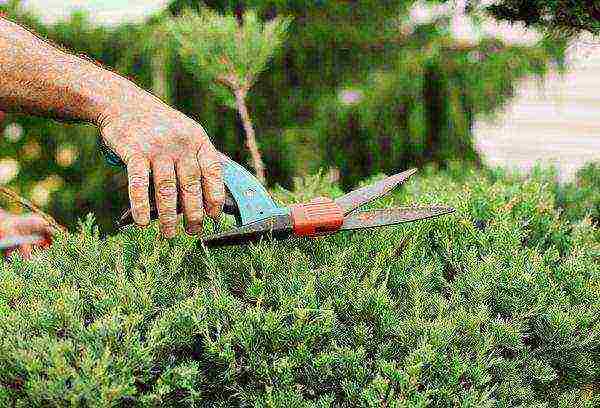
In order for a young juniper to successfully winter in the country, it must be protected from frost and bright sun. Shelter is usually only required in the very first winter after planting.
How to cover young seedlings for the winter:
- Cone-shaped trees are tied with ropes so that the branches do not break under the weight of the snow.
- Plants are covered with air-permeable material. It is allowed to use burlap, cotton fabric, kraft paper.
- To cover young bushes with spruce branches, it is placed from bottom to top in two layers.
- In particularly cold winters, a double shelter is made.
- The fabric or spruce branches are not removed until March, so that the bush or tree does not suffer from the bright spring sun. Common juniper varieties are especially susceptible to burning.
Regardless of the type and variety, the juniper works in the summer cottage as a natural air purifier.Planting an ephedra will not take much effort, as well as caring for it, but the decorative properties of a growing tree or bush will not cease to amaze gardeners.
 An amazing coniferous plant, the common juniper, is widespread in nature over vast territories. Juniper is a unique conifer bearing cones that ripen among the tough needle-like needles. This article is all about the correct agrotechnology for growing juniper, the timing of planting a plant in the open field, proper care and a variety of varieties. To get acquainted with the plant, we bring to your attention a selection of photos.
An amazing coniferous plant, the common juniper, is widespread in nature over vast territories. Juniper is a unique conifer bearing cones that ripen among the tough needle-like needles. This article is all about the correct agrotechnology for growing juniper, the timing of planting a plant in the open field, proper care and a variety of varieties. To get acquainted with the plant, we bring to your attention a selection of photos.
Description: varieties and varieties of common juniper
Common juniper can be considered a long-liver among conifers, the plant easily reaches the age of 600 years. In nature, the habitat of the juniper is delineated by areas with a temperate climate on the European continent, in North America, on the northern coast of Africa.
Juniper belongs to the Cypress family. The shrub reaches a height of 3 meters, and juniper trees can grow up to 12 meters.
Among the varieties of juniper, there are monoecious and dioecious plants, which differ in the shape of the crown and the appearance of the cone berries. Evergreen juniper varieties reproduce well by seeds, the first fruits on plants can be obtained in 5-10 years (depending on growing conditions and plant variety).
Juniper leaves are reduced into pointed thorny needles, needles are located on the branches in groups, there are usually 3 pieces in whorls. On branches, needles live up to 4 years.
Since ancient times, juniper has been used to treat a number of diseases in many peoples. It is known that the North American Indians used the plant to treat tuberculosis - patients were resettled in thickets of juniper trees, where they were healed, inhaling the smell of pine needles. In Russia, dwellings were fumigated with the smoke of juniper branches during epidemics.
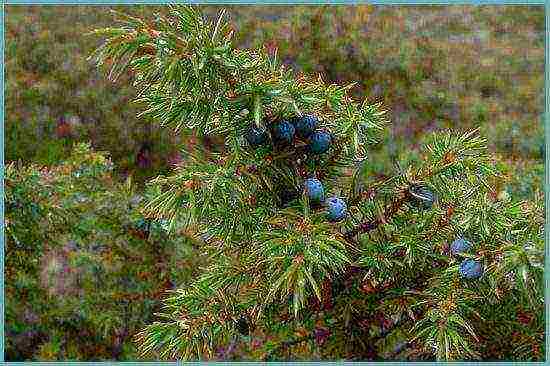
There are over 70 varieties of juniper
The genus of junipers has up to 70 varieties, among which the following varieties can be considered the most popular:
- In 2 - the plant has a slender narrow crown, which does not exceed 30 cm in diameter. The height of the plant reaches 3 meters, which is often used by landscape designers to give the garden a certain style.
- Columnaris is a low columnar plant with a blunt top.
- Compressa - the height of the juniper of this variety does not exceed 1 meter. The plant does not tolerate severe frosts, the crown needs to be covered during severe cold weather.
- Gold beach - a low elfin tree with an open golden crown.
- Gold Cone is a tall plant, reaching 4 meters, with a narrow crown, the color of the needles is golden.
Juniper: correct planting
It is best to plan the planting of juniper in open ground in spring, you do not need to wait for the onset of stable heat, enough for the snow cover to begin to melt. When planting plants in the autumn, there is a great threat of freezing. Young juniper saplings, planted in the garden in autumn, do not have time to adapt to a new place, as the first frosts bind the ground.

With proper planting, the culture takes root easily
A somewhat different picture develops when planting container plants, the root system of which is not subjected to severe stress during transplantation - such seedlings take root well in a new place in spring, autumn and even summer.
For planting juniper in the open field, you need to choose the sunniest place, although this species can tolerate some shading.
Important! The intensity of illumination of plants completely affects the development and decorative qualities of the thorny juniper bushes. This is especially important for the cultivation of two-color varieties.
Common juniper prefers soils with an alkaline reaction, therefore, when planting, slaked lime or dolomite flour should be added to the pit.The plant does not tolerate stagnant water at the roots, therefore it is very important to ensure reliable drainage, especially if the groundwater level relative to the surface is high enough.
Important! Transplanting adult junipers into open ground is possible only in winter if the transplanted specimen grew outdoors. In this case, it is necessary to dig a plant with a voluminous lump of frozen earth.
When planting young junipers, it is required to prepare square pits with sides of 1x1 m, the depth is provided for up to 0.5 m, but the pit should have dimensions of at least three times the size of an earthen coma.
The root collar of the plant should not be covered with soil, therefore, the seedling must be carefully placed in the planting pit, pouring soil under the roots until the collar of the tree is at the level of the soil surface.
The first watering is carried out immediately after planting, abundantly soaking the soil under the seedling. The trunk circle must be mulched immediately after planting, so that moisture will remain in the soil longer. Peat chips, bark of conifers (pine), shavings, sawdust can be used as mulch.
Common juniper care
Common juniper does not require special care, the plant develops perfectly in one place for several hundred years, the main thing when growing is sufficient sunlight.
The plant does not require frequent watering, the ephedra is quite enough moisture from precipitation. However, young plants need watering on hot summer days (2-3 times per season).
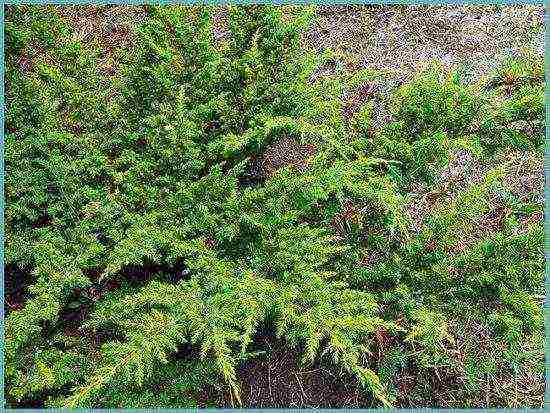
Juniper does not require frequent watering
We will talk about fertilization below. Sometimes a juniper needs sanitary care - pruning broken and dried branches that need to be cut to healthy tissue, and cover the wound surface with garden varnish. The formative pruning of plants is difficult to endure - the crown slowly grows in the ephedra.
Winter care - young plants should be covered with lutrasil during very severe frosts.
Juniper: feeding and fertilizing
Juniper care includes regular feeding with the introduction of special fertilizers, including special nutrient mixtures for conifers. Young plants can be fed once a month with mineral or organic fertilizers. In the spring-summer period, it is required to use organic compounds, closer to autumn - mineral dressings. In late autumn, special fertilizers for conifers of prolonged action can be scattered over the soil surface.
Plant propagation: common juniper
It is allowed to propagate the juniper in several ways: by seeds, cuttings, grafting, layering.
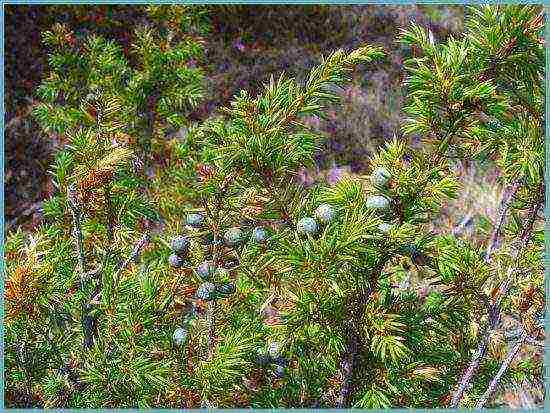
Juniper propagates easily by cuttings
The most common breeding method for common juniper is grafting... With this method, a high percentage of survival of young conifers is observed. Rooting is best done in early spring, for which it is necessary to cut heel cuttings from healthy coniferous bushes. Cuttings are treated with root stimulants and planted in separate boxes. For better rooting, cuttings should be sprayed frequently with a spray bottle.
Growing young seedlings from seeds is not always successful, therefore it is recommended to use this method only for breeding work.
Diseases and pests of conifers: juniper
Junipers are characterized by diseases caused by fungal infections. Mostly weakened plants that are grown without following the rules of agricultural technology are affected. Signs of the onset of the disease: browning or yellowing of the needles, drying out of the tips of the shoots, rusty bloom on the branches.
A particularly dangerous infection is considered to be the defeat of conifers with the Schütte fungus. The needles on the branches of the juniper turn orange, subsequently, areas of damage by the black fungus appear.Such branches must be cut and burned.
To protect plants from fungal infections, special preparations are used and proper care of the plants is provided.
In addition to infections, pests can attack tender juniper seedlings, especially aphids, spider mites, and scale insects annoy plants. To get rid of pests, you should use special means: "Actellik", "Fufanon", "Fitoverm".
Combining juniper with other plants
Speaking about the combination of common juniper with other plants when creating landscape compositions, it should be noted the high decorative qualities of the plant. Juniper fits perfectly into compositions with deciduous and coniferous trees, perennial and annual flowering crops. A particularly successful combination of plants can be achieved when planting different varieties of juniper with colored and green needles. Juniper looks great when creating tall hedges, as well as when planting as a tapeworm on a lawn.
Common juniper: video
Growing juniper: photo
